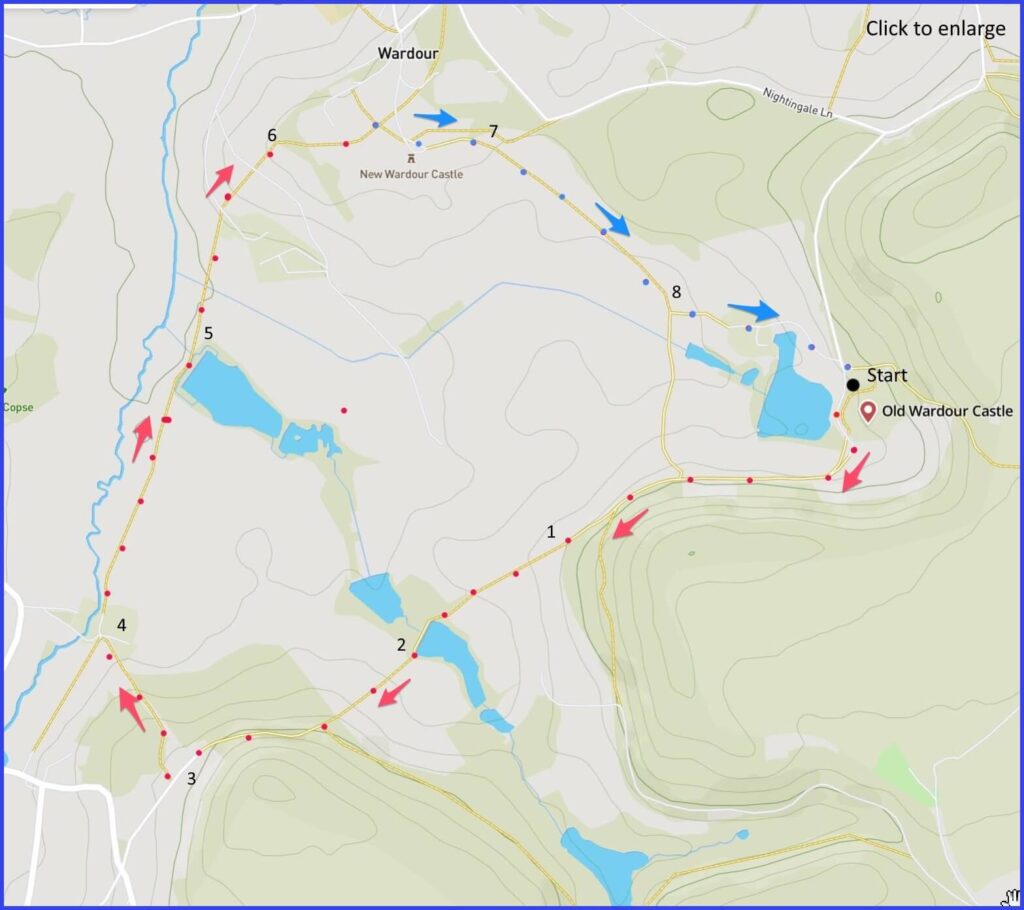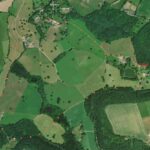A 3.5 mile walk around Wardour castles. Some stiles. Mainly flat lanes and field paths: straight lines with a few sharp turns. Lots of silence. Click map to enlarge. Water is blue, wooded green, contour lines show slopes. Click here for an aerial view. Click here to download one-page PDF. (There is a GPX route option here for phone/tablet download. But only follow this link after watching this GPX help video). Friendly warning: all files relating to walks are published here in good faith but on the understanding that users must be responsible for their own safety and wellbeing.
(Route from map points + metres to next point)
Start: From the Old Castle car park, follow the lane between castle walls and lake. Pass Banqueting Buidling [D]. Veer right leaving farm building on your left. Path becomes wooded on your left and open to right [E]. Take right fork path (ignore gated arch). Reach open field. 820m
1: Walk forward to water pond. 430m
2: Cross water. Stiled gate. Open field. Gate. Wood. Right path at junction. Stile. Gate. Woods. Meet lane. 600m
3: Take path shortly on right towards farm. 350m
4: Join lane, left towards farm, through farmyard to gate. Forward with river to Park Pond (hidden beyond tree growth) 600m
5: Forward to stream crossing path. Cross stream. Walk towards red-roofed farm house. Cross lane at gate to its left. Uphill towards wood. 500m
6: Stile,through wood. Follow yellow route markers to cross in front of new castle, then veering away to it and right [I]. 400m
7: Cross open field towards farm buildings (dense wooded area to your left). 600m
8: At lane gate take left path towards them. At forge, follow left path round towards castle car park. 520m
The pictures below are in the order things were seen on this walk. Clicking on any one will enlarge it (and the slideshow)
The route covers a landscape developed across 600 years by one family – the Arundells of Cornwall. This is a Norman family, with firm Catholic roots – a faith that got them in and out of various kinds of trouble. The route is a rough circle. It starts at the ‘Old Castle’ and returns via the ‘New Castle’. Strictly speaking, neither is really a castle at all. The ‘Old’ – now in ruin – was conceived more as a ‘fortified house’. While the ‘New’ is simply “the finest Georgian mansion in Wiltshire” (so says Pevsner).
The Old
It’s hard to get here without a car. Even then, the approach roads are all bends and single track. Yet the journey is well rewarded by arrival at this beautifully secluded site. Outside of summer break there is even a chance that there will be no one else there (aside from staff). Wandering around (and up) the full extent of the old ruin is encouraged, and that is an unusual experience. In the grounds there are the Arundell’s homemade grottos, a lake, a banqueting house [C], and a mediaeval toilet (rest assured, there’s a modern one as well). Find a non-wordy version of what you can expect to view in this ariel video.
The original castle was commissioned in 1392 by the 5th Baron John Lovell (sometimes called ‘Lovell the Rich’). It was the first hexagonally-shaped ‘castle’ in England – inspired by typical French chateau design. Later (1461) it was confiscated from the 9th Baron Lovell, him having supported the wrong side in the Wars of the Roses (Richard III). The castle then changed hands a few times before finally (1547) entering the Arundell family through Sir Thomas Arundell (1st Baron). When he was beheaded in 1552 (conspiracies linked to his Catholicism), Old Castle was confiscated yet again. However, his son Sir Matthew Arundell bought it back in 1570 and transformed the core into what has been termed ‘a Spenserian fantasy’: a place appropriate to an age of chivalry. The ‘fantasy’ included the innovation of glazed windows: again, perhaps more house then castle.
A story much told of this ‘castle’ concerns the wife of Sir Thomas Arundell (that is the 2nd Baron Thomas). While her Royalist husband was away supporting the King, Lady Blanche Arundell was obliged to defend their castle against a force of 1300 Parliamentary soldiers (1643). This she famously did for six days – with just 25 men and her maidservants. When she finally surrendered, Lady Arundell and her children were spared but made prisoners in Shaftesbury. (This standard story is colourful, but English Heritage do advise applying a pinch of Arundell salt.) The Arundell family later recovered the property (1680s) but eventually decided to build a new castle (see below), rather than developing the old. A fuller and more visual history of the old castle is available in this video.
The New
The 8th Lord Arundell commissioned this ‘castle’ (er, ‘Georgian mansion’) in 1770. The Arundell family apparently regarded the Old Castle as kind of quaint garden feature (cf. garden buildings at Stourhead). The family remained here until the last Arundell died, heirless, in 1945. At which time it was purchased by the Society of Jesus.
The Jesuits leased it to the charity Cheshire Homes. But by 1957 they could no longer afford to maintain it. Whereupon it became the Cranbourne Chase boarding school for girls, at least until 1990. At this point the house was purchased (with tennis courts, swimming poll and cottages) for £1m by Canary Wharf property developer, Nigel Tursley. He converted it into ten large apartments, while living in the centre of the house himself (‘The Apartment’). Sadly, the property boom ceased booming and Tursley was obliged to put his Wardour project on the market – optimistically for £7m (it sold for £2.75m). Nigel Tursley now has a cottage in the grounds from which he operates as a busy eco-warrior – with special interest in carbon capture.
In 2010 designer Jasper Conran snapped up ‘The Apartment’ and applied his faultless taste to furnishing it. Hear him talking about his love for the place in this video tour – before he sold it in 2020 for £4m.
The apartments in this ‘castle’ are still occupied. However, as a walking visitor to the site you will not be able to look inside. In fact there have been a number of attempts to close up even the path that takes you pleasingly across the front of the building. However, this will never be easy as the route is part of the Wessex Ridgeway.
One feature of the New ‘Castle’ that does enjoy occasional public use (at least if you are a local worshipping Catholic) is the splendid All Saints Chapel. You you will notice on the right side of the building [I] as you pass. It remains in irregular use and, because of its excellent acoustics, the other (more secular) way of getting inside is to go to one of the occasional concerts there.
For a more earthly final moment on your walk, do notice the Old Wardour Forge on your path back to the starting point.



![[A]](https://wiltshirewalks.com/wp-content/uploads/2022/09/wardour01-150x150.jpg)
![[B]](https://wiltshirewalks.com/wp-content/uploads/2022/09/wardour02-150x150.jpg)
![[C]](https://wiltshirewalks.com/wp-content/uploads/2022/09/wardour03-150x150.jpg)
![[D]](https://wiltshirewalks.com/wp-content/uploads/2022/09/wardour04-150x150.jpg)
![[E]](https://wiltshirewalks.com/wp-content/uploads/2022/09/wardour05-150x150.jpg)
![[F]](https://wiltshirewalks.com/wp-content/uploads/2022/09/wardour06-150x150.jpg)
![[G]](https://wiltshirewalks.com/wp-content/uploads/2022/09/wardour07-150x150.jpg)
![[H]](https://wiltshirewalks.com/wp-content/uploads/2022/09/wardour08-150x150.jpg)
![[I]](https://wiltshirewalks.com/wp-content/uploads/2022/09/wardour09-150x150.jpg)